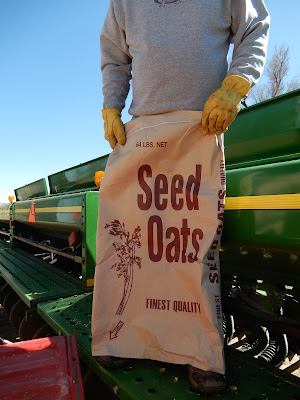When I was a kid, one set of grandparents lived in Haskell County. To a child, it seemed like it took FOREVER to get to western Kansas from the south central part of the state. One of my memories of those long car rides was of my dad singing nonsense songs. One of them went like this:
Mares eat oats
And does eat oats
And little lambs eat ivy
A kid'll eat ivy, too,
Wouldn't you?
When sung quickly, it ends up sounding more like this:
Marezedotes,
and doezedotes
and littlelambszedivy
Akidllivytoo
Wouldn't you?
Other songs in my dad's car repertoire included "Tumbling Tumbleweeds" and "I'm An Old Cowhand from the Rio Grande."
I must admit the old song formed an ear worm as Randy planted oats last week. Horses and deer eat oats, but we're hoping to have some to feed our cattle, too.
Randy planted the oats in an old alfalfa field. He used the disc to lightly break up the soil and to kill volunteer cheat and other weeds. Then, he planted the oats, using the same drill we use to plant wheat.
Disking up the alfalfa wouldn't be a "normal" thing to do. But it's an old field, and this is its last "hurrah." After we harvest the oats/alfalfa combination, Randy will disc up the field. But this final cutting should provide a mixture of alfalfa and oats that we can bale up for cattle feed. An alfalfa field is productive about 7 to 8 years.
He planted 2 bushels of oats per acre.
A bushel of oats only weighs 32 pounds, compared to 60 pounds per bushel of wheat.
There's not a big market for oats in our area. We can't haul them to the grain elevator. But they will provide good feed for our cattle.
These are "haying" oats vs. "grain" oats. These will get taller than other varieties.
The oats are also a good source of nutrition for our cattle herd. At the end of May or the first part of June, he will
swath the field and then
bale it.
Randy had the co-op apply a fertilizer with nitrogen, phosphate, sulfur and zinc. Even though he wasn't concerned with grain yield, he thought the ground was low in nutrients.
It costs about $57.00 per acre to plant the oats, figuring cost of seed, fertilizer and use of the machinery. The cost of oats had gone up considerably since the last time we'd planted them two years ago. But it should yield a couple of tons of oats and alfalfa for that last cutting. That will increase the value of the last cutting of the hay and provide good feed for feeder cattle.
And there you have it: The song may be nonsense, but we're hoping the oat planting makes perfect sense.











What happens to the alfalfa field at the end of the season? Do you plant a cover crop and let it sit for a few years?
ReplyDeleteAfter we take the oats/hay off, we will plant wheat in the fall. Usually, a field that has had alfalfa on it is more productive than average. Alfalfa produces its own nitrogen, so the roots will decompose and will provide good nutrients for the next crop.
ReplyDelete